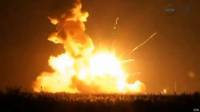- October 29, 2014
Post

Launcher “Antares” with an American spacecraft “Cygnus” exploded at the start. One of the versions of explosion experts call malfunction engines.
The explosion occurred a few seconds after take-off from the Baikonur NASA Wallops Island, off the coast of that of the US state of Virginia.
The rocket was to deliver in orbit for more than two tons of cargo for the six astronauts who are on the International Space Station.
With the explosion no one was hurt. A team of NASA experts currently ascertain the reasons for the disaster.
Soviet track?
The investigation will not jump to conclusions about the causes of the collapse of the carrier rocket. However, one of the possible versions could be a bug in the main engines.
Launcher “Antares” – the fruit of international cooperation.
Как reported on the manufacturer’s website – Orbital Sciences Corporation – design of the fuel tank of the first stage was developed in Ukrainian “Southern”. This bureau was once established carrier rocket “Zenit”.
The very fuel tank was built in Dnepropetrovsk enterprise “Southern Machine-Building Plant”, which builds the “Zenith” and “Cyclone”.
The first stage of the rocket engines equipped AJ26-62, which are supplied by the US company Aerojet Rocketdyne.
On the website, the company says that AJ26-62 – the result of a deep revision Russian rocket engines NK-33, created on the Samara plant SNTK them. ND Kuznetsova.
This engine – the closest relative of the NK-15, which was set on the most powerful Soviet rocket H1. Rocket N1 was supposed to participate in the Soviet lunar program. All tests rocket ended in failure, and the program was curtailed as a result.
According to Aerojet Rocketdyne, revision includes the installation of the engine gimbal deflection system to change the thrust vector, new fuel system, updated wiring and some other systems .
Delayed disaster
The launch vehicle and spacecraft, manufactured by Orbital Sciences, is part of NASA’s replacement shuttle flights. The purpose of the program – providing freight cost to orbit the Earth.
Frank Culbertson, deputy chairman of the Orbital Sciences, expressed confidence that the accident will not affect the long-term plans of the company.

Originally the launch was appointed on Monday. However, due to the presence of a marine vessel in the waters of the Baikonur launch was delayed.
The flight was supposed to be on the third Mrs. commissioned by the US National Aeronautics and Space Administration (NASA).
“I hope that soon we will understand what happened, and resumed work,” – said Frank Culbertson.
Correspondent BBC -bi Jonathan Amos BBC believes that the delay in the delivery of cargo into orbit will be negligible. The company has a number of cargo ships that can deliver the goods.
No comments:
Post a Comment